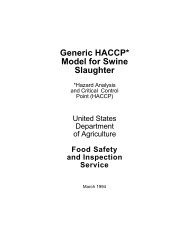Generic HACCP Model for Thermally Processed Commercial
Generic HACCP Model for Thermally Processed Commercial
Generic HACCP Model for Thermally Processed Commercial
Create successful ePaper yourself
Turn your PDF publications into a flip-book with our unique Google optimized e-Paper software.
samples of meat or sea-food, none exceeded the tolerance level of 3 p.p.m.<br />
Ludwigsen, R.J. 1982. Container contribution to lead in canned foods. Rivista della Societa<br />
Italiana di Scienza dell'Alimentazione 11(6):369-382.<br />
Aspects discussed include: production and food/beverage use of metal cans in the USA;<br />
regulatory concern about Pb in foods; voluntary ef<strong>for</strong>ts by the food industry to reduce Pb<br />
levels; the relatively high potential <strong>for</strong> Pb contamination of evaporated milk in vent hole<br />
cans; measures to minimize dietary Pb intake by children; Pb in relation to the canmaking<br />
operation; contamination by visible solder pellets or sub-visual Pb dust; testing <strong>for</strong> Pb in<br />
cans and canned products; current Pb levels in canned foods; container-derived Pb in the<br />
diet; and alternatives to lead-soldered cans.<br />
Prosic, Z., et al. 1987. [Organochlorine pesticides in canned meat.] Hrana I Ishrana<br />
28(4)199-202.<br />
28 samples of (i) canned luncheon meat and 30 of (ii) canned liver pate, from 4<br />
manufacturers, were analysed <strong>for</strong> residues of organochlorine pesticides. (i) samples from<br />
2 manufacturers exceeded the tolerances <strong>for</strong> lindane and total DDT, average concn. being<br />
0.956 mg/kg <strong>for</strong> lindane, 0.974 mg/kg <strong>for</strong> total DDT (approx. double the Yugoslav<br />
tolerance). The (i) samples from the other 2 manufacturers, and all (ii) samples, had<br />
organochlorine pesticide residue concn. well below the tolerance; residue concn. were<br />
higher in these (i) samples than in (ii).<br />
Renesse, R. L., van and J. W. Klumper. 1993. [Glass in foods: prevention is not always possible.]<br />
Voedingsmiddelentechnologie 26(24):31-34.<br />
Contamination of foods with glass is discussed with reference to: the inevitability that<br />
contamination with glass fragments will occasionally occur; the consequent need <strong>for</strong><br />
efficient inspection; preventive measures; inspection of foods <strong>for</strong> glass fragments; optical<br />
inspection; X-ray detection; other detection methods (acoustic, microwave, metal<br />
detector, gamma-irradiation); diagnosis; and future possibilities.<br />
Sanchez-Saez, J. J., et al. 1981. Lead (Pb)and Copper (Cu) contents of canned cooked meals.]<br />
Boletin del Centro Nacional de Alimentacion y Nutricion No. 5, 14-17.<br />
Lead (Pb) and Copper (Cu) contents were determined by AAS in 328 canned foods.<br />
Results, shown graphically and in a table, revealed that Pb contamination was due mainly<br />
to the manufacturing process or the can, Cu mainly to the raw material. Values <strong>for</strong> Pb<br />
were mainly between 0 and 500 parts/billion (p.p.b.). Only 3.6% of the samples contained<br />
greater than 2 p.p.m. Pb, though 20% of canned vegetables contained greater than 1<br />
p.p.m. 190 samples contained less than2 p.p.m. Cu, only 11 samples greater than 7 p.p.m.<br />
and only 1 sample greater than 12 p.p.m.<br />
74



